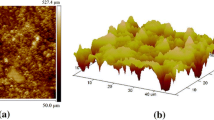Abstract
Development of microstructure of early cement paste (0–6 h) was investigated with 1H low-field NMR. It was found that T 2 (transverse relaxation time) distributions of fresh cement paste were bimodal and two peaks were ‘long component’ and ‘short component’. Separation degree of two peaks was a sign of exchange of water within flocculation and outside flocculation. Factors such as water cement ratio, specific surface area and dosage of superplasticizer had influences on the separation degree: the separation degree increased with the water cement ratio; the separation degree of cement paste prepared with cement with a high specific surface area was zero; dosage of superplasticizer will decrease separation degree. Results also suggested that T 2 distribution gradually moved to the left and T 2 of long component and initial fluidity were linearly correlated.
Similar content being viewed by others
References
Y M Zhang, Y F Luo. The Aplication of Low-field Pulsed Nuclear Magnetic Resonance System[J]. Mod. Sci. Instrum., 2003 (2): 52–54
W Yao, A M She, P Q Yang. 1H-NMR Relaxation and State Evolvement of Evaporable Water in Cement Pastes[J]. J. Chin. Ceram. Soc., 2009, 37(10): 1 602–1 606
J Y Jehng. Microstructure of Wet Cement Pastes a Nuclear Magnetic Resonance Study [D]. Evanston: Northwestern University, 1995
J P Gorce, N B Milstone. Probing the Microstructure and Water in Composite Cement Blends[J]. Cement Concrete Res., 2007, 37: 310–318
J Y Jehng, D T Sprague, and W P Halperin. Pore Structure of Hydrating Cement Paste by Magnetic Resonance Relaxation Analysis and Freezing [J]. Magn. Reson. Imaging, 1996, 14: 785–791
N Nestle, C Zimmermann, M Dakkouri, et al. Transient High Concentration of Chain Anions in Hydration Cement — Indications From Spin Relaxation Measurements [J]. J. Phys. D Appl. Phys., 2002, 35: 166–171
P Pipilikaki, M Katsioti. Study of The Hydration Process of Quaternary Blended Cements and Durability of the Produced Mortars and Concretes [J]. Constr. Build. Mater., 2009, 23: 2 246–2 250
A M SHE, W YAO. Probing the Hydration of Composite Cement Pastes Containing Fly Ash and Silica Fume by Proton NMR Spin-Lattice Relaxation[J]. Sci. China Technol. Sci., 2010, 53(6): 1 471–1 476
L Pel, K Kopinga, and H Brocken. Determination of Moisture Profiles in Porous Building Materials by NMR [J]. Magn. Reson. Imaging, 1996, 14: 931–932
L Pel, K Hazrati, and K Kopinga. Water Absorption in Mortar Determined by NMR [J]. Magn. Reson. Imaging, 1998, 16: 525–528
H F W Taylor. Cement Chemistry [M]. New York: Thomas Telford Publishing, Thomas Telford Services Ltd., 1992
B G Mao, R Z Dong, L Zhang, et al. Research of the Initial Hydration Process and Structure Formation of Portland Cement [J]. J. Wuhan University of Technology, 2004, 26(7): 17–19
B G Mao Baoguo, R Z Dong, Y H Xu, et al. Research of the Rheology Characteristic and Structure Formation of Portland Cement Initial Hydration [J]. J. of Railway Sci. and Eng., 2004, 1(9): 26–29
Z P Sun, M Pang, Y Yu, et al. Effect of Superplasticizer on Transverse Relaxation Time Curve of Cement Paste [J]. J. Chin. Ceram. Soc., 2011, 39(3): 537–543
K R Brownstein, C E Tarr. Importance of Classical Diffusion in NMR Studies of Water in Biological Cells [J]. Phys. Rev. A, 1979, 19(6): 2 446–2 453
K J Dunn, D J Bergman, Latorraca G A. Nuclear Magnetic Resonance Petrophysical and Logging Applications[M]. London: Pergamon, 2002
F F Paméla, R Stéphane. Proton NMR Relaxation as a Probe for Setting Cement Pastes[J]. Magn. Reson. Imaging, 2008, 26: 1 183–1 196
R L Kleinberg. Utility of NMR T 2 Distributions, Connection with Capillary Pressure, Clay Effect, and Determination of the Surface Relaxivity Parameter ρ 2 [J]. Magn. Reson. Imaging, 1996, 14: 761–767
Author information
Authors and Affiliations
Corresponding author
Additional information
Funded by the National Natural Science Foundation of China (No. 51178339), and the National Basic Research Program (No. 2009CB623104-5)
Rights and permissions
About this article
Cite this article
Yu, Y., Sun, Z., Pang, M. et al. Probing development of microstructure of early cement paste using 1H low-field NMR. J. Wuhan Univ. Technol.-Mat. Sci. Edit. 28, 963–967 (2013). https://doi.org/10.1007/s11595-013-0801-7
Received:
Accepted:
Published:
Issue Date:
DOI: https://doi.org/10.1007/s11595-013-0801-7




